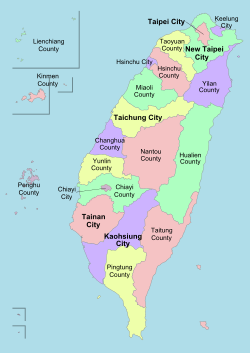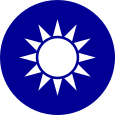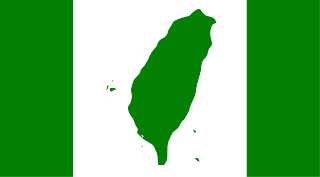
The Taiwan independence movement is a political movement which advocates the formal declaration of an independent and sovereign Taiwanese state, as opposed to Chinese unification or the status quo in Cross-Strait relations.

"Mainland China", also "the Chinese mainland", is the territory under direct administration of the People's Republic of China (PRC) in the aftermath of the Chinese Civil War. In addition to the geographical mainland, the geopolitical sense of it includes islands such as Hainan, Chongming, and Zhoushan. By convention, territories outside of mainland China include:

The president of the Republic of China, also referred to as the president of Taiwan, is the head of state of the Republic of China (Taiwan) as well as the commander-in-chief of the Republic of China Armed Forces. The position once had authority of ruling over Mainland China before 1949, but its remaining jurisdictions has been limited to Taiwan, Penghu, Kinmen, Matsu, and other smaller islands since the conclusion of the Chinese Civil War.

Kinmen, alternatively known as Quemoy, is a group of islands governed as a county by the Republic of China (Taiwan), only 10 km (6.2 mi) east from the city of Xiamen in Fujian, located at the southeastern coast of the People's Republic of China, from which they are separated by Xiamen Bay. Kinmen is also located 187 km (116 mi) west from the closest shoreline of the island of Taiwan across the Taiwan Strait.
Taiwan is divided into multi-layered statutory subdivisions. Due to the complex political status of Taiwan, there is a significant difference in the de jure system set out in the original constitution and the de facto system in use today.
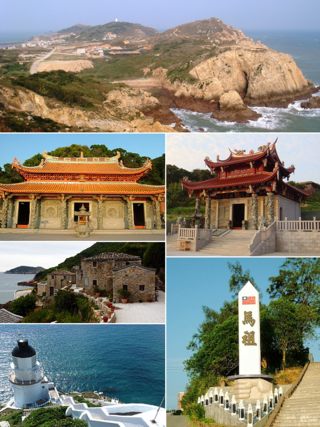
The Matsu Islands, officially Lienchiang County, are an archipelago of 36 islands and islets in the East China Sea governed by the Republic of China (Taiwan), situated alongside the southeastern coast of mainland China. The archipelago forms the smallest county in the ROC-controlled territories by area and population, as well as one of two counties that is a part of the nominal Fuchien Province.
"Chinese Taipei" is the term used in various international organizations and tournaments for groups or delegations representing the Republic of China (ROC), a country commonly known as Taiwan.
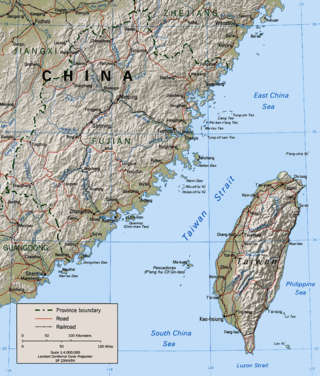
The First Taiwan Strait Crisis was a brief armed conflict between the People's Republic of China (PRC) and the Republic of China (ROC) in Taiwan. The conflict focused on several groups of islands in the Taiwan Strait that were held by the ROC but were located only a few miles from mainland China.

Fuchien Province, also romanized as Fujian and rendered as Fukien, is a nominal province of the Republic of China without formal administrative function. It includes three small archipelagos off the coast of the Fujian Province of the People's Republic of China, namely the Matsu Islands, which make up Lienchiang County, and the Wuqiu Islands and Kinmen Islands, which make up Kinmen County. The seat of the administrative centre is Jincheng Township of Kinmen County which serves as its de facto capital. The province is also known as the Golden Horse, after the literal reading of the Chinese character abbreviation for "Kinmen-Matsu".
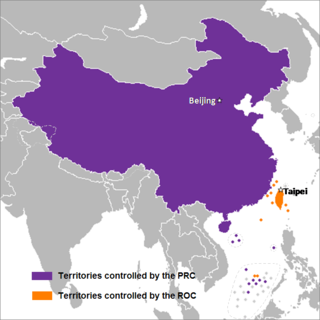
"Taiwan, China", "Taiwan, Province of China", and "Taipei, China" are controversial political terms that claim Taiwan and its associated territories as a province or territory of the People's Republic of China.

Taiwan Province, PRC refers to a notional administrative division claimed by the People's Republic of China. The PRC constitution asserts Taiwan as part of its territories although the PRC has never controlled Taiwan since the PRC's establishment in 1949. The territory of the claimed province, including the entire island of Taiwan, is in actuality administered by the Republic of China (ROC) but is not coextensive with the smaller Taiwan Province of the ROC.

The Exit & Entry Permit for Taiwan, Republic of China is the document for the bearer to enter into and/or depart from the Taiwan Area, namely Taiwan, Penghu, Kinmen and Matsu. Currently, there are several types of Exit & Entry Permit that reflect the bearer's residency status. The permit is issued by the National Immigration Agency of the Republic of China (Taiwan). For different purposes, the permit is also known as:

The concept of Two Chinas refers to the political divide between the People's Republic of China (PRC) and the Republic of China (ROC). The PRC was established in 1949 by the Chinese Communist Party, while the ROC was founded in 1912 and retreated to Taiwan after losing the Chinese Civil War.

The following outline is provided as an overview of and topical guide to Taiwan:
"Mutual non-recognition of sovereignty and mutual non-denial of authority to govern" is former President of the Republic of China Ma Ying-jeou's description of the relations between the Taiwan Area and Mainland China, as presented in his second inauguration speech after being re-elected in 2012. Sometimes the term special non-state-to-state relations is used in the press for this concept, following his own statements. Ma defines the relations as a "special relationship for which the model of [state] recognition under conventional international law is not applicable". This marks a departure from the views of his predecessors, former presidents Lee Teng-hui's special state-to-state relations and Chen Shui-bian's One Country on Each Side: Both defined the Republic of China (ROC) and the People's Republic of China (PRC) as states and the relationship between the two as one between two states. In Ma's view, the ROC government considers the one China as the ROC, regardless of the view of the PRC government. While neither governing authority can recognize that in the other area as a legitimate state, neither would deny the other side being the de facto governing authority of its area.
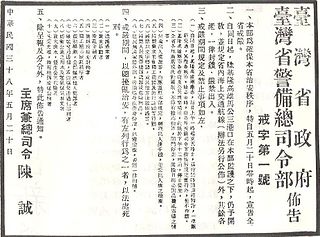
Martial law in Taiwan refers to the periods in the history of Taiwan after World War II, during control by the Republic of China Armed Forces of the Kuomintang-led regime. The term is specifically used to refer to the over 38-year-long consecutive martial law period between 20 May 1949 and 14 July 1987, which was qualified as "the longest imposition of martial law by a regime anywhere in the world" at that time.
Period of mobilization for the suppression of Communist rebellion is a political term used by the Kuomintang-led government of the Republic of China to indicate the country's entering into a state of emergency with the raising Chinese Civil War. The term aimed to mobilize the people and resources under Kuomintang's control to fight with the Chinese Communist Party rebellion.
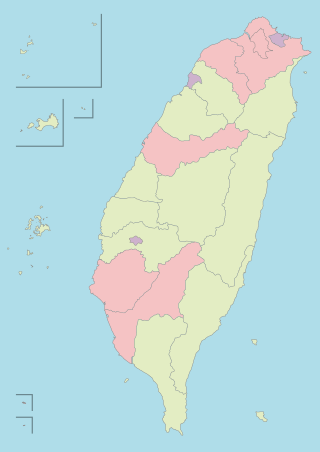
A county, constitutionally known as a hsien, is a de jure second-level administrative division unit in the Republic of China (Taiwan). Under the administrative structure of Taiwan, it is with the same level of a provincial city.
